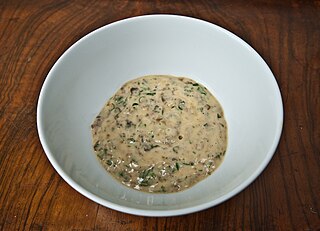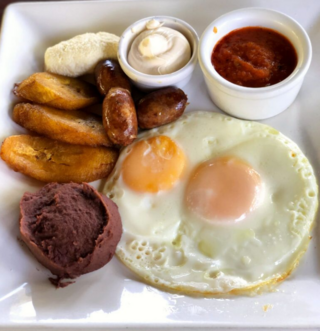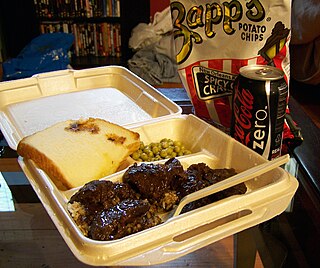
Cajun cuisine is a style of cooking developed by the Cajun–Acadians who were deported from Acadia to Louisiana during the 18th century and who incorporated West African, French and Spanish cooking techniques into their original cuisine.

The cuisine of the Southern United States encompasses diverse food traditions of several subregions, including cuisine of Southeastern Native American tribes, Tidewater, Appalachian, Ozarks, Lowcountry, Cajun, Creole, African American cuisine and Floribbean, Spanish, French, British, and German cuisine. In recent history, elements of Southern cuisine have spread to other parts of the United States, influencing other types of American cuisine.

Tomato sauce can refer to many different sauces made primarily from tomatoes, usually to be served as part of a dish, rather than as a condiment. Tomato sauces are common for meat and vegetables, but they are perhaps best known as bases for sauces for Mexican salsas and Italian pasta dishes. Tomatoes have a rich flavor, high water content, soft flesh which breaks down easily, and the right composition to thicken into a sauce when stewed, without the need for thickeners such as roux or masa. All of these qualities make them ideal for simple and appealing sauces.

Gravy is a sauce generally made from the juices of meats and vegetables that run naturally during cooking and often thickened with corn starch or other thickeners for added texture. The gravy may be further coloured and flavoured with gravy salt or gravy browning or bouillon cubes. Powders can be used as a substitute for natural meat or vegetable extracts. Canned and instant gravies are also available. Gravy is commonly served with roasts, meatloaf, rice, noodles, fries (chips), mashed potatoes, or biscuits.

Louisiana Creole cuisine is a style of cooking originating in Louisiana, United States, which blends West African, French, Spanish, and Native American influences, as well as influences from the general cuisine of the Southern United States.

Gumbo is a stew that is popular in the U.S. state of Louisiana and is the official state cuisine. Gumbo consists primarily of a strongly flavored stock, meat or shellfish, a thickener, and the Creole "holy trinity" – celery, bell peppers, and onions. Gumbo is often categorized by the type of thickener used, whether okra or filé powder.

Jambalaya is a savory rice dish of mixed origins that developed in the U.S. state of Louisiana apparently with African, Spanish, and French influences, consisting mainly of meat or seafood, and vegetables mixed with rice and spices. West Africans and Spanish people each had versions of jambalaya in their respective countries. Historian Ibraham Seck states Senegalese people were making jambalaya. The French introduced tomato to West Africans and they incorporated the crop into their one-pot rice dishes that created jambalaya and enhanced jollof rice. Spanish people made paella which is also a one-pot rice dish cooked with meats and vegetables. These styles of cuisines blended in Louisiana and resulted in cultural and regional variations of the dish.

A po' boy is a sandwich originally from Louisiana. It traditionally consists of meat, which is usually roast beef, ham, or fried seafood such as shrimp, crawfish, fish, oysters, or crab. The meat is served in New Orleans French bread, known for its crisp crust and fluffy center.

Trinidad and Tobago has a unique history and its food is influenced by Indian-South Asian, West African, Creole, European, American, Chinese, Amerindian, and Latin American culinary styles. Trinidadian and Tobagonian food is dominated by a wide selection of dishes, most notably, doubles, roti, pelau, callaloo and curried crab and dumplings. Trinidad and Tobago is also known for its prepared provisions, such as dasheen, sweet potato, eddoes, cassava, yam, soups and stews, also known as blue food across the country. Corresponding to the Blue Food Day event held annually in Trinidad and Tobago.

Rémoulade is a cold sauce. Although similar to tartar sauce, it is often more yellowish, sometimes flavored with curry, and often contains chopped pickles or piccalilli. It can also contain horseradish, paprika, anchovies, capers and a host of other items.

Salvadoran cuisine is a style of cooking derived from the nation of El Salvador. The indigenous foods consist of a mix of Amerindian cuisine from groups such as the Lenca, Pipil, Maya Poqomam, Maya Chʼortiʼ, Alaguilac and Cacaopera peoples and some African influences. Many of the dishes are made with maize (corn). There is also heavy use of pork and seafood. European ingredients were incorporated after the Spanish conquest.

Étouffée or etouffee is a dish found in both Cajun and Creole cuisine typically served with shellfish over rice. The dish employs a technique known as smothering, a popular method of cooking in the Cajun and Creole areas of south Louisiana. Étouffée is most popular in New Orleans and in the Acadiana region as well as the coastal counties of Mississippi, Alabama, northern Florida, and eastern Texas.

Dirty rice is a traditional Louisiana Creole dish made from white rice which gets a "dirty" color from being cooked with small pieces of pork, beef or chicken, green bell pepper, celery, and onion, and spiced with cayenne and black pepper. Parsley and chopped green onions are common garnishes. Dirty rice is most common in the Creole regions of southern Louisiana; however, it can also be found in other areas of the American South and referenced as "chicken and rice," "Cajun rice," or "rice dressing".
Oysters en brochette is a classic dish in New Orleans Creole cuisine. Raw oysters are skewered, alternating with pieces of partially cooked bacon. The entire dish is then broiled or breaded then either deep fried or sautéed. The traditional presentation is on triangles of toast with the skewer removed and dusted with salt and pepper or topped with either Maitre d'Hotel butter or a Meunière sauce. When prepared well, the dish should have a crispy exterior and a soft savory center with a textural contrast between the bacon and the oyster. It was usually offered on restaurant menus as an appetizer; but was also a popular lunch entrée.

Seafood boil in the United States is the generic term for any number of types of social events in which shellfish, whether saltwater or freshwater, is the central element. Regional variations dictate the kinds of seafood, the accompaniments and side dishes, and the preparation techniques. In some cases, a boil may be sponsored by a community organization as a fund-raiser or a mixer. In this way, seafood boils are like a fish fry, barbecue, or church potluck supper. Boils are also held by individuals for their friends and family for a weekend get-together and on the holidays of Memorial Day and Independence Day. While boils and bakes are traditionally associated with coastal regions of the United States, there are exceptions.

Haitian cuisine is a Creole cuisine that originates from a blend of several culinary styles that populated the western portion of the island of Hispaniola, namely African, French, indigenous Taíno, Spanish and Arab influences. Haitian cuisine has some similarities with "criollo" cooking and similar to the rest of the Caribbean, but differs in several ways from its regional counterparts. Flavors are bold and spicy demonstrating African and French influences, with notable derivatives coming from native Taíno and Spanish techniques.

Dried shrimp are shrimp that have been sun-dried and shrunk to a thumbnail size. They are used in many African, East Asian, Southeast Asian and South Asian cuisines, imparting a unique umami taste. A handful of shrimp is generally used for dishes. The flavors of this ingredient are released when allowed to simmer.

Smothering meat, seafood or vegetables is a cooking technique used in both Cajun and Creole cuisines of Louisiana. The technique involves cooking in a covered pan over low heat with a moderate amount of liquid, and can be regarded as a form of stove-top braising. The meat dishes cooked in this fashion are typically served over boiled or steamed white rice as a rice and gravy, while the vegetables are typically served as side dishes.































